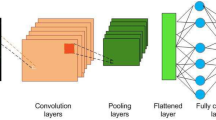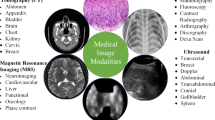Abstract
In this paper, offer a new framework for skin disease image recognition using deep learning techniques and local descriptor encoding approaches. For the purpose of detecting melanoma early, skin lesions must be accurately classified. In this research, an automatic image preprocessing approach is proposed for the removal of noise artefacts in photographs, including thin and thick hair objects, surgical ink markings, dark halo effects, and ebony frames. Due to hazy contrasts and distortions at the border margins, segmenting images are quite challenging. So, this research suggests a partitioning technique based on a fuzzy gray-level co-occurrence matrix (GLCM) that is both effective and adaptive. An alternative to convolutional neural networks (CNN) is proposed: the capsule-based network. An object's existence and the relationship between its functions are represented by a group of neurons (in logical units) that make up a vector called a capsule. While synthetic product neural networks use max-pooling layers to define capsule coupling between subsequent layers, capsule networks repeatedly utilise a dynamic routing technique to do so. Alternatively said, the routing-by-agreement approach offers learning between capsule layers. To assess the efficacy of the F-CapsNet technique, three widely used datasets—the ISIC 2017 Challenge, the 2019 Challenge, and the PH2 datasets—are employed. The suggested technique has an average accuracy of 99.16% for the ISBI 2017 test dataset and 99.45% accuracy for the ISBI 2019 test dataset. Additionally, the PH2 test dataset shows that the suggested approach has an average accuracy of 98.42%.












Similar content being viewed by others
Availability of data and materials
Data sharing not applicable to this article as no datasets were generated or analysed during the current study.
References
Boaro JMC, Cutrim dos Santos PT et al (2020) Hybrid capsule network architecture estimation for melanoma detection. In: International conference on systems, signals and image processing (IWSSIP), Niteroi, Brazil, pp 93–98
Cruz MV, Namburu A, Chakkaravarthy S, Pittendreigh M, Satapathy SC (2020) Skin cancer classification using convolutional capsule network (CapsNet). J Sci Ind Res 79(11):994–1001
Fritsch P, Burgdorf W (2006) The skin and its diseases: an overview. Eur J Dermatol 16(1):209–212
Litjens G, Kooi T, Bejnordi BE, Setio AAA, Ciompi F, Ghafoorian M et al (2017) A survey on deep learning in medical image analysis. Med Image Anal 42:60–88
Liu Y, Jain A, Eng C et al (2020) A deep learning system for differential diagnosis of skin diseases. Nat Med 26(1):900–908
Marks RM, Knight AG, Laidler P (2012) Atlas of skin pathology. Springer, Amsterdam
Pal A, Chaturvedi A, Garain U, Chandra A, Chatterjee R (2016) Severity grading of psoriatic plaques using deep CNN based multi-task learning. In: 23rd International conference on pattern recognition (ICPR 2016), Cancun, Mexico, pp 1478–1483
Pal A, Chaturvedi A, Garain U, Chandra A, Chatterjee R, Senapati S (2018) CapsDeMM: capsule network for detection of Munro’s microabscess in skin biopsy images. In: International conference on medical image computing and computer-assisted intervention (MICCAI 2018), Granada, Spain, pp 389–397
Pal A, Garain U, Chandra A, Chatterjee R, Senapati S (2018) Psoriasis skin biopsy image segmentation using deep convolutional neural network. Comput Methods Programs Biomed 159(1):59–69
Roy A, Pal A, Garain U (2017) JCLMM: a finite mixture model for clustering of circular-linear data and its application to psoriatic plaque segmentation. Pattern Recogn 66(1):160–173
Russakovsky O, Deng J, Su H, Krause J, Satheesh S, Ma S, Huang Z et al (2015) Imagenet large scale visual recognition challenge. Int J Comput Vision 115(3):211–252
Sabour S, Frosst N, Hinton GE (2017) Dynamic routing between capsules. In: International conference on advances in neural information processing systems, Long Beach, USA, pp 3856–3866
Tiwari S (2021) Dermatoscopy using multi-layer perceptron, convolution neural network, and capsule network to differentiate malignant melanoma from benign nevus. Int J Healthc Inf Syst Inform 16(3):58–73
Tizek L, Schielein MC, Seifert F et al (2019) Skin diseases are more common than we think: screening results of an unreferred population at the munich oktoberfest. Eur Acad Dermatol Venereol 33(1):1421–1428
Tschandl P, Rosendahl C, Kittler H (2018) The HAM10000 dataset, a large collection of multi-source dermatoscopic images of common pigmented skin lesions. Sci Data 5(1):1–9
Pustokhina IV, Pustokhin DA, Gupta D, Khanna A, Shankar K, Nguyen GN (2020) An effective training scheme for deep neural network in edge computing enabled internet of medical things (IoMT) systems. IEEE Access 8:107112–107123
Raj RJS, Shobana SJ, Pustokhina IV, Pustokhin DA, Gupta D, Shankar K (2020) Optimal feature selection-based medical image classification using deep learning model in internet of medical things. IEEE Access 8:58006–58017
Shankar K, Lakshmanaprabu SK, Khanna A, Tanwar S, Rodrigues JJ, Roy NR (2019) Alzheimer detection using Group Grey Wolf Optimization based features with convolutional classifier. Comput Electr Eng 77:230–243
Shankar K, Zhang Y, Liu Y, Wu L, Chen CH (2020) Hyperparameter tuning deep learning for diabetic retinopathy fundus image classification. IEEE Access 8:118164–118173
Oghaz MM, Maarof MA, Rohani MF, Zainal A, Shaid SZM (2019) An optimized skin texture model using gray-level co-occurrence matrix. Neural Comput Appl 31:1835–1853
Elhoseny M, Shankar K, Uthayakumar J (2019) Intelligent diagnostic prediction and classification system for chronic kidney disease. Sci Rep 9(1):1–14
Li H, He X, Zhou F, Yu Z, Ni D, Wand T, Lei B (2019) Dense deconvolutional network for skin lesion segmentation. IEEE J Biomed Health Inf 23(2):527–537. https://doi.org/10.1109/JBHI.2018.28598
Yu Z, Jiang X, Zhou F, Qin J, Ni D, Chen S, Lei B, Wang T (2018) Melanoma recognition in dermoscopy images via aggregated deep convolutional features. IEEE Trans Biomed Eng 66:1006–1016
Annamalai M, Muthiah PB (2022) An early prediction of tumor in heart by cardiac masses classification in echocardiogram images using robust back propagation neural network classifier. Braz Arch Biol Technol. https://doi.org/10.1590/1678-4324-2022210316
Balamurugan D, Aravinth SS, Reddy PCS, Rupani A, Manikandan A (2022) Multiview objects recognition using deep learning-based wrap-CNN with voting scheme. Neural Process Lett 54:1–27. https://doi.org/10.1007/s11063-021-10679-4
Manikandan A, Jamuna V (2017) Single image super resolution via FRI reconstruction method. J Adv Res Dyn Control Syst 9(2):23–28
Vijayalakshmi S (2022) Early detection of breast cancer using robust back propagation neural network classifier. Rom Biotechnol Lett. 27(2):3407–3415. https://doi.org/10.25083/rbl/27.2/3407.3415
Ashokkumar N, Meera S, Anandan P, Murthy M, Kalaivani KS, Alahmadi T, Alharbi S, Raghavan S, Jayadhas S (2022) Deep learning mechanism for predicting the axillary lymph node metastasis in patients with primary breast cancer. BioMed Res Int. https://doi.org/10.1155/2022/8616535
Acknowledgements
Not applicable.
Funding
No funding received by any government or private concern.
Author information
Authors and Affiliations
Contributions
RA contributed to technical and conceptual content, architectural design. AM contributed to guidance, and JX counselling on the writing of the paper.
Corresponding author
Ethics declarations
Conflict of interest
The authors declare that they have no competing interests.
Additional information
Publisher's Note
Springer Nature remains neutral with regard to jurisdictional claims in published maps and institutional affiliations.
Rights and permissions
Springer Nature or its licensor (e.g. a society or other partner) holds exclusive rights to this article under a publishing agreement with the author(s) or other rightsholder(s); author self-archiving of the accepted manuscript version of this article is solely governed by the terms of such publishing agreement and applicable law.
About this article
Cite this article
Ali, R., Manikandan, A. & Xu, J. A Novel framework of Adaptive fuzzy-GLCM Segmentation and Fuzzy with Capsules Network (F-CapsNet) Classification. Neural Comput & Applic 35, 22133–22149 (2023). https://doi.org/10.1007/s00521-023-08666-y
Received:
Accepted:
Published:
Issue Date:
DOI: https://doi.org/10.1007/s00521-023-08666-y




